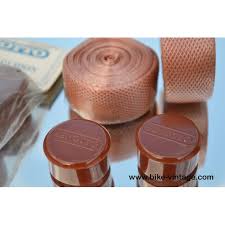It came in a rainbow of colors and was, by far, the lightest product in its category. It was easy to apply and use, and even easier to replace. As delicate as it seemed, it actually fared as well--or, at least no worse--than any other item in its category.
Even at 25 cents, nobody wanted it. So, in the first bike shop in which I worked, we threw it out..
Fast-forward a few years: I'm working in another bike shop. Everyone, it seemed, wanted the stuff we tossed out of the previous shop. Some even grew irate when we didn't have the color(s) they wanted.
What happened? Well, the '70's became the '80's. Neon colors became all the rage in everything from ski wear to cycle gear. ( I rode several winters in a hot pink-and-black Italian cycling jacket.) Some riders wanted multiple colors to create all sorts of patterns and special effects.
What am I describing?

It's something you may well have used if you're about my age. Maybe you're still using it. If you weren't born the first time it was en vogue, you may have discovered it recently and think it's the coolest stuff you've ever seen.
I'm talking about a thin cellophane handlebar tape from Benotto. Almost no bar wrap was ever slicker or shinier. I, like many other riders, wondered how that stuff could ever provide any kind of grip.

Truth was, it didn't. And that was part of its appeal, especially if you were a time trialist or some other kind of super-fast rider. You see, its surface made it easier to change hand positions on long rides. On the other hand (pun intended), the only thing resembling grip the tape provided came from the overlaps.
I'll admit, I used a couple of sets myself. On my black Cannondale road bike, I wrapped my bars with red Benotto tape; on my Trek 510, I used a rather nice set in a kind of shimmery café crème hue.

The tape could be had in almost any shade imaginable, as well as in certain patterns, including the flags of Italy, France, Germany and other countries.

By the time customers were demanding it, the price had gone up to around a dollar. At that price, you didn't worry about tearing it in a fall or some other mishap! And it took practically no time to rewrap a bar with new Benotto tape.
I don't know how long it stayed on the market. From what I could tell, production seemed to have stopped some time around 1990. These days, new-old-stock Benotto tape goes for as much as $25 (yes, for a two-roll set) on eBay. And some company is making reproductions of the thin cellophane tape.
Imagine that: A "retro" product made of cellophane.
Even at 25 cents, nobody wanted it. So, in the first bike shop in which I worked, we threw it out..
Fast-forward a few years: I'm working in another bike shop. Everyone, it seemed, wanted the stuff we tossed out of the previous shop. Some even grew irate when we didn't have the color(s) they wanted.
What happened? Well, the '70's became the '80's. Neon colors became all the rage in everything from ski wear to cycle gear. ( I rode several winters in a hot pink-and-black Italian cycling jacket.) Some riders wanted multiple colors to create all sorts of patterns and special effects.
What am I describing?
It's something you may well have used if you're about my age. Maybe you're still using it. If you weren't born the first time it was en vogue, you may have discovered it recently and think it's the coolest stuff you've ever seen.
I'm talking about a thin cellophane handlebar tape from Benotto. Almost no bar wrap was ever slicker or shinier. I, like many other riders, wondered how that stuff could ever provide any kind of grip.
Truth was, it didn't. And that was part of its appeal, especially if you were a time trialist or some other kind of super-fast rider. You see, its surface made it easier to change hand positions on long rides. On the other hand (pun intended), the only thing resembling grip the tape provided came from the overlaps.
I'll admit, I used a couple of sets myself. On my black Cannondale road bike, I wrapped my bars with red Benotto tape; on my Trek 510, I used a rather nice set in a kind of shimmery café crème hue.
The tape could be had in almost any shade imaginable, as well as in certain patterns, including the flags of Italy, France, Germany and other countries.
By the time customers were demanding it, the price had gone up to around a dollar. At that price, you didn't worry about tearing it in a fall or some other mishap! And it took practically no time to rewrap a bar with new Benotto tape.
I don't know how long it stayed on the market. From what I could tell, production seemed to have stopped some time around 1990. These days, new-old-stock Benotto tape goes for as much as $25 (yes, for a two-roll set) on eBay. And some company is making reproductions of the thin cellophane tape.
Imagine that: A "retro" product made of cellophane.
